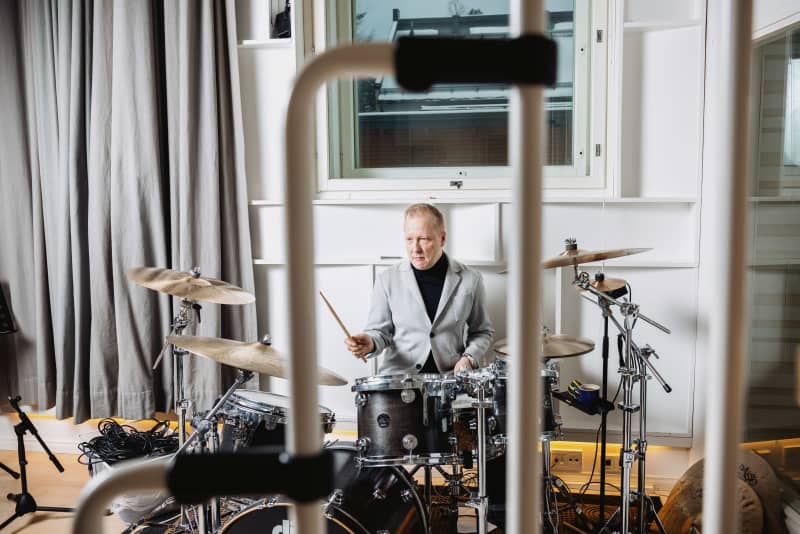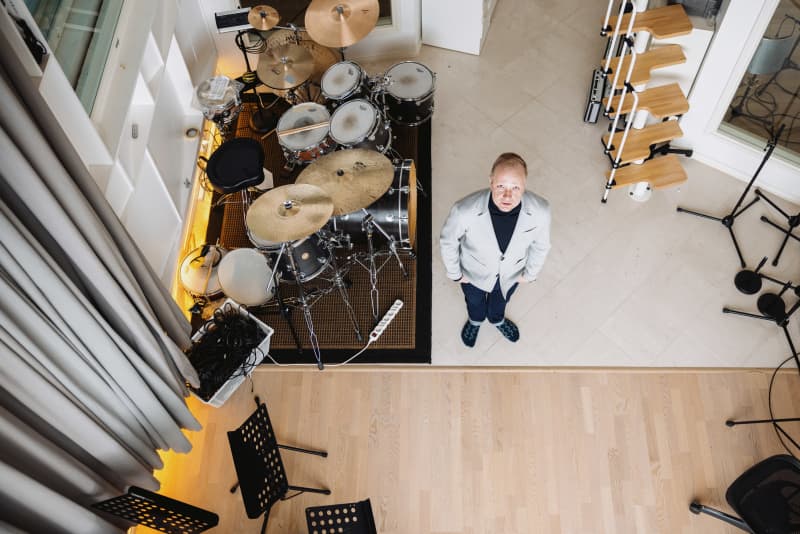
Cultural guest Kalle Torniainen has been involved in the bands of television entertainment programs for over ten years.
Saturday and the best place is the sofa. Something delicious within reach. Turn on the television.
The presenter, dressed in glitter, welcomes the viewers after the theme music. His excited voice rises towards the end of the opening spike.
*\”And Kalle Torniainen’s band is responsible for the music!\”*
The camera picks up a close-up shot of a man dressed in a neat suit playing the drums enthusiastically. He doesn’t look at the camera. And you don’t have to. The connection to home sofas is created through music.
Now Torniainen is preparing for Finland’s biggest TV night, Independence Day. Torniainen leads the band playing in the Linna continuation after the reception of the President of the Republic for the tenth time already.

Career started at the age of 5 at Mikko Alatalo’s home studio
– I was no longer interested in anything else. I didn’t even want to go to Särkänniemi, I wanted to bang the drums.
On the way home, the parents asked if Kalle would like to go to drum lessons. There was no need to ask the question twice. Soon, the drum teacher picked up the 5-year-old from kindergarten to play while the others went to nap.
My love for music deepened with my father’s huge floor-to-ceiling record collection. There were about 4,000 records.
Torniainen’s first musical love was heavier rock like Kiss and Mötley Crüe. Little by little, the taste in music expanded from one style to another, from pop to jazz, as my father’s collection covered numerous musical genres with key works.

Enthusiasm for music took Torniainen from drum lessons to music college and through several bands to Pop
However, any kind of gig experience was valuable for a beginning musician. Torniainen says that it was important to practice and perform with professionals.
However, combining school and concert life was contradictory.
– The conditions were really good and we ate well, and then on Monday we had to go back to school.
– I realized that I am still a musician at heart and a band leader type of character.
The king of TV entertainment programs
Ylen’s Elämäni biisi program has become hugely popular. This autumn’s fourth production season has gathered an audience of millions.
Kalle Torniainen has led the program’s orchestra since the beginning. According to Torniainen, making the song \”Elämäni\” is especially great because of the exceptional spirit of the team, which is born from the fact that everyone appreciates each other’s professionalism. He also has experience in the cooler atmosphere of TV productions.
In Torniainen’s opinion, the experience they have gathered from TV productions can now be used better than ever before.
– The work is different from previous programs and it shows. There is something special about it.

The final result of the entertainment programs is created by the cooperation of the creators and the studio audience. But the band leader has a very special role.
It involves a lot of planning and advance work, which is not visible to the viewers.
Torniainen takes, for example, the song Elämäni. Although the program is presented in the fall, the first planning meetings are already held at the beginning of the year.
During the spring, a large number of guests and songs are raked through. We then try to get functioning entities from them into episodes. According to Torniainen, it is a big puzzle.
By Midsummer, the guests of the episodes will be locked. After that, the arrangement of the songs and training for performance starts. Practicing takes time, as almost 80 songs are accumulated during one season.
The director of the orchestra makes sure that the artists and musicians are up to date with everything arranged and, above all, that the schedule is kept.
The budget also dictates its own conditions. In Finnish TV productions, there is not enough money for long training. In the song of my life, there is not even an actual training day, but the episode is practiced on the same day before the broadcast.
You’d think that the tight schedule would make the orchestra director a nervous wreck, but Torniainen seems calm. He knows what he’s doing. He is a professional.
– When advance work is done well and carefully, it is uncomplicated, pleasant and efficient. Then you can just enjoy playing with the band.

One song stands above the rest
So what about Torniainen’s own life song?
He has heard dozens of touching stories about music and life from behind the drum set. Of course, you have also thought about your own choice and the story behind it. It’s not easy even for a music professional.
The song’s melody and harmony put him in strong Finnish moods. He listens to the tunes of Sibelius on concert trips or vacations abroad with his family. Then he sees in his mind the familiar Finnish lake landscape and feels peace.
– Finlandia takes me to my hometown Kainuuse and the dangerous landscapes of Sotkamo. You can say that it is the best song in the world.
Torniainen has a special relationship with the majestic work also because he plays it with his band every year as the last song of Linna’s sequels. It is also a moving moment for the musician.
– The song is our national property and a song made by Janne. There is something genuine and real about it, the musician sums up.
The Finnish audience demands honesty
Decades of gigging throughout Finland has given Torniainen a good idea of \u200b\u200bwhat kind of music sinks into Finns.
We often talk about the melancholy of Finnish music, but in the musician’s opinion, Finns’ musical taste is actually richer and more international than the minor-key image.
In fact, according to Tornaiinen’s experience, Finns are spoiled by songs that have dared to be made against the current trend.
He takes, for example, Kaija Koo’s *Who invented love* song from the early 1990s. At that time, all the record companies said that a woman couldn’t sing that style of music. However, it became a huge success.
– When enough uncles or aunts at the record company say that this kind of thing can’t be done, then there might be ingredients for something bigger. It really touches and plays the strings of our Finns’ souls a little deeper.

But the most important thing is authenticity. In Torniainen’s opinion, it has to be in the music, or else the Finnish public, who demands honesty, won’t buy it.
At its best, music opens the emotional locks of rigid Finns.
– When a Finn shows his feelings, there is nothing inauthentic about it. It lacks the syrupy frosting.
The authenticity of music is hard to put into words, but Torniainen has learned the best lesson from Vesa-Matti Loir.
– He said that if you can make a movement in one person’s heart, it is very likely that you can make it happen in many others.
Years in the glare of the studio lights have taught Torniainen when this happens.
*You can discuss the article until 23:00 on December 5.*
